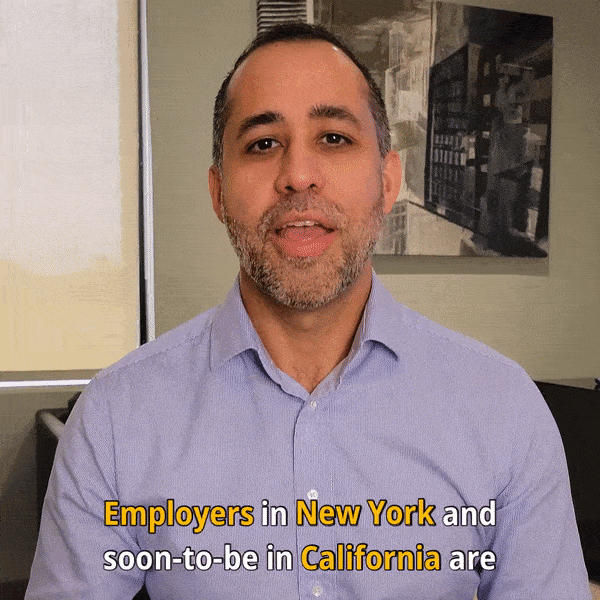If your employee comes to work with a cough, high fever, red eyes and an itchy rash, you have to assume that everyone in the room has just been exposed to the measles.
It’s a strange phenomenon because the disease is both very preventable and very contagious. In 2000, the Center for Disease Control declared that measles had been eradicated in the US. Nonetheless, ninety percent of the people who have no immunity, either through vaccination or because a very few had the disease, will become infected by that employee. The number of vulnerable workers may be higher than you think.
Recent outbreaks seem to be linked to antivaxxers, or depending on your political orientation, to immigration from Mexico, where the measles vaccination rate is higher than it is in the US.
Nonetheless, measles has snatched the headlines from Ebola. But it is hardly the only infectious disease that could blister your business. Realistically, the most serious perennial threat, and one against which a vaccine is also routinely recommended, is not measles, but influenza.
What risks does your business face from infectious disease outbreaks, and what are your legal obligations as an employer? Can you just insist that employees be vaccinated? These questions get to the delicate legal balance between safety and privacy that is now more complicated than many employers appreciate.
Legal Implications of Infectious Disease
There are a variety of state and federal laws that govern an employer’s response to workplace diseases.
Occupational Safety and Health Act
Under what is generally referred to as the “general duty clause,” an employer has the obligation to protect employees against recognized hazards to safety or health that may cause serious injury or death. The general duty clause doesn’t explicitly mention infectious disease. However, OSHA may use nationally recognized standards, including recommendations issued by the CDC or the National Institute for Occupational Safety and Health to determine if a contagious disease does represent a hazard covered by the law.
If OSHA were to establish that your employees were reasonably likely to be exposed to a particular disease because of travel or work in healthcare, for example, the agency could require your business to develop a plan and procedures to protect them and others who came to the worksite and could be exposed.
OSHA’s standards include things such as a hazard assessment, employee awareness training, the use of personal protective equipment, (e.g. masks), a means to report infection and provide medical surveillance for employees who contract the disease and maintenance of a log for illnesses which are occupationally related. The nurses who were exposed to Ebola patients come immediately to mind.
This kind of intervention is more likely to happen in a hospital or other healthcare setting, but having a plan to prevent or respond to an outbreak of contagious disease that includes at least some of these elements is not a bad way to prevent to prevent escalation of either a disease or regulatory enforcement. It’s hard to run a business if your employees are sick, your customers stay away or if you have to spend a lot of time on the disease log.
Workers Compensation Disability Benefits
In general, and subject to state-specific requirements, if an employee contracts a disease as a result of occupational exposure, the employee is entitled to receive temporary total disability benefits in lieu of wages, reasonable and necessary medical treatment and an award for any resulting permanent disability. Some of what we think of as “childhood diseases,” including chicken pox and the mumps, which are now largely prevented through vaccination, can have very serious and potentially permanent health consequences for adults. The savvy employer might take another look at worker’s compensation insurance coverage and coverage limits that include occupational diseases.
If an employee contracts a disease that it is not occupationally related and becomes disabled, he or she may become entitled to disability benefits if the employer provides them.
An employer should consider whether the employee is infectious, what type of treatment is necessary, whether the employee presents a health risk to others including co-workers and clients and when the employee can safely return to work. This will take advice from a medical professional with expertise in infection control who can also advise on worker’s compensation issues.
Paid Sick Leave
Various states, including California require employers to provide employees with paid sick leave. In California, the law covers employees who work more than 30 days a year. Employers must provide these workers with at least 3 paid sick days per year, although many provide more. The real benefit to the employer is that paid sick days may encourage sick employees to stay home and may limit the spread of disease to coworkers and customers.
Beyond paid leave, employers with more than 50 employees are required to provide up to twelve weeks of unpaid leave to a qualified employee who has a serious health condition. An employee is also eligible under FMLA in the event of a similarly serious health condition affecting its spouse, child or parent. If an employee contracts the measles, this disease may be considered a serious health condition warranting the unpaid leave. Similarly, if an employee’s parent, spouse or a child contracts the measles, this will likely be a qualifying event entitling the employee to use leave time to care for a family member.
Since the CDC generally recommends excluding sick people from the workplace to prevent further transmission, an employer may have to place the employee on FMLA leave or some other form of leave despite the employee’s desire to continue working.
Americans with Disabilities Act
The ADA protects employees who may have physical, mental or emotional disabilities but who are otherwise qualified to perform the essential functions of their jobs. Typically, a disability is a chronic impairment which substantially limits one or more major life activities. Infectious diseases are ordinarily temporary and do not qualify as a disabilities. However, complications do occur.
The ADA may become a factor if an employee develops a disability as a result of the disease and cannot return to his or her former work duties because of the impairment. An employer must then be prepared to engage in a case-by-case evaluation about the employee’s ability to return to work, any work restrictions, what accommodations may be available without undue hardship to the employer or whether the employee’s disability presents a direct threat to the health or safety of the employee or other employees.
What if a worker returns to work after a nasty bout of whooping cough and, even after time to get back into the swing of things, does not appear to be able to his or her former job? The employer cannot inquire about the existence of a disability, but may ask about the need for altered work conditions. If no reasonable accommodation is possible, an employer has no obligation to retain the employee, although this could be a legally fraught decision if the employee contracted the disease which resulted in the disability in the course of employment.
Health Insurance Portability and Accountability Act
HIPAA, among its many other functions, also protects the privacy of personally identifiable health information. There is an exception for public health purposes during a disaster such as an influenza pandemic that would permit hospitals to share otherwise identifiable information.
This does not appear to apply to employers, however. Although an employer may apparently share information about the risk posed by an outbreak of infectious disease, it must be extremely careful not to disclose information that would identify the employee.
Premises Liability
Under general common law principles, a landowner owes third parties who come on to the premises, such as clients, vendors, or contract employees, a duty of reasonable care to protect them against hazards which are not obvious. If the landowner is or should be aware that there are infectious employees who may create a health hazard to others, there may be a duty to warn them or to prevent access to certain areas.
In the event that the building ventilation system or washroom facilities become contaminated, the landowner may have an obligation to prevent the spread of disease through enhanced measures. The legal duty of the landowner for site security and sanitation is sually defined in the lease. Both the landlord and tenant, if the employer is the tenant, should review it and any other related documents to confirm what the obligations to third parties may be.
What’s an Employer To Do?
There is no need to become a complete germaphobe, but ignoring the business and legal risk of contagious disease isn’t an option either. The widespread immunity to diseases like the measles, against which many people are vaccinated, is not perfect, and adults with compromised immune systems may be particularly at risk. Following are 8 tips to protect your business and your employees from the hazards of infectious disease:
- Periodic employee education is essential. You may not think your business should have to stress the importance of basic hygiene including hand washing, sneeze etiquette and staying home when sick, but it may make a big difference in the health of your workplace and your business’s potential legal liability if you do.
- Even if you are not legally obligated to do so, consider offering at least some paid sick leave.
- Perform routine environmental cleaning.
- Consider remote or other alternative work environments for employees who are sick or at higher risk of infection.
- Exclude sick employees from the workplace. Send them home. The ADA permits this if the illness poses a direct threat.
- Although you may not be able to ask about a specific illness, you may inquire about symptoms. Exercise care when asking these questions of asymptomatic employees. All personal medical information must, of course, be treated as confidential.
- If appropriate to the disease risk, employers may ask travel-related questions.
- Ask employees who have been out of the workplace because of illness to present a doctor’s note on return.
What can’t an employer do? Employers cannot take employees’ temperatures and generally, except for hospital workers, cannot compel employees to be vaccinated. This is particularly an issue with annual flu vaccines.
Title VII of the Civil Rights Act, the ADA and various state human rights laws protect employees who have religious, ethical or medical objections to these mandates. Employers can beg, cajole and incentivize vaccinations, but can go no further.
Just as you take steps to protect your business from fire or other natural disaster, you must take steps to protect it from the risk of infectious disease outbreaks. Although workers’ compensation coverage plays a role, culture is king. The biggest safety move is behavioral. Education, training and vigilance to health risks is a way to protect your workers and your bottom line.


![Unraveling the Workforce: Navigating the Aftermath of Mass Layoffs [e322]](https://www.pashalaw.com/wp-content/uploads/2023/07/Untitled-design-23-1024x723.png)
![Return to the Office vs. Remote: What Can Employers Legally Enforce? [e321]](https://www.pashalaw.com/wp-content/uploads/2023/01/Pasha_LSSB_321_banner-1024x723.jpg)


![California v. Texas: Which is Better for Business? [313]](https://www.pashalaw.com/wp-content/uploads/2021/07/Pasha_LSSB_CaliforniaVSTexas-1024x723.jpg)




![Employers vs. Employees: When Are Employment Restrictions Fair? [e318]](https://www.pashalaw.com/wp-content/uploads/2022/05/Pasha_LSSB_EmployeesVsEmployers_banner-1-1024x723.jpg)






![Law in the Digital Age: Exploring the Legal Intricacies of Artificial Intelligence [e323]](https://www.pashalaw.com/wp-content/uploads/2023/11/WhatsApp-Image-2023-11-21-at-13.24.49_4a326c9e-300x212.jpg)
![Unraveling the Workforce: Navigating the Aftermath of Mass Layoffs [e322]](https://www.pashalaw.com/wp-content/uploads/2023/07/Untitled-design-23-300x212.png)
![Return to the Office vs. Remote: What Can Employers Legally Enforce? [e321]](https://www.pashalaw.com/wp-content/uploads/2023/01/Pasha_LSSB_321_banner-300x212.jpg)
![Explaining the Hans Niemann Chess Lawsuit v. Magnus Carlsen [e320]](https://www.pashalaw.com/wp-content/uploads/2022/10/LAWYER-EXPLAINS-7-300x169.png)
![California v. Texas: Which is Better for Business? [313]](https://www.pashalaw.com/wp-content/uploads/2021/07/Pasha_LSSB_CaliforniaVSTexas-300x212.jpg)
![Buyers vs. Sellers: Negotiating Mergers & Acquisitions [e319]](https://www.pashalaw.com/wp-content/uploads/2022/06/Pasha_LSSB_BuyersVsSellers_banner-300x212.jpg)
![Employers vs. Employees: When Are Employment Restrictions Fair? [e318]](https://www.pashalaw.com/wp-content/uploads/2022/05/Pasha_LSSB_EmployeesVsEmployers_banner-1-300x212.jpg)
![Vaccine Mandates Supreme Court Rulings [E317]](https://www.pashalaw.com/wp-content/uploads/2022/02/WhatsApp-Image-2022-02-11-at-4.10.32-PM-300x212.jpeg)
![Business of Healthcare [e316]](https://www.pashalaw.com/wp-content/uploads/2021/11/Pasha_LSSB_BusinessofHealthcare_banner-300x212.jpg)
![Social Media and the Law [e315]](https://www.pashalaw.com/wp-content/uploads/2021/10/WhatsApp-Image-2021-10-06-at-1.43.08-PM-300x212.jpeg)
![Defining NDA Boundaries: When does it go too far? [e314]](https://www.pashalaw.com/wp-content/uploads/2021/09/Pasha_LSSB_NDA_WordPress-2-300x212.jpg)
![More Than a Mistake: Business Blunders to Avoid [312] Top Five Business Blunders](https://www.pashalaw.com/wp-content/uploads/2021/06/Pasha_LSSB_Blunders_WP-1-300x212.jpg)
![Is There a Right Way to Fire an Employee? We Ask the Experts [311]](https://www.pashalaw.com/wp-content/uploads/2021/02/Pasha_LSSB_FireAnEmployee_Website-300x200.jpg)
![The New Frontier: Navigating Business Law During a Pandemic [310]](https://www.pashalaw.com/wp-content/uploads/2020/12/Pasha_LSSB_Epidsode308_Covid_Web-1-300x200.jpg)
![Wrap Up | Behind the Buy [8/8] [309]](https://www.pashalaw.com/wp-content/uploads/2020/11/Pasha_BehindTheBuy_Episode8-300x200.jpg)
![Is it all over? | Behind the Buy [7/8] [308]](https://www.pashalaw.com/wp-content/uploads/2020/09/iStock-1153248856-overlay-scaled-300x200.jpg)
![Fight for Your [Trademark] Rights | Behind the Buy [6/8] [307]](https://www.pashalaw.com/wp-content/uploads/2020/07/Fight-for-your-trademark-right-300x200.jpg)
![They Let It Slip | Behind the Buy [5/8] [306]](https://www.pashalaw.com/wp-content/uploads/2020/06/Behind-the-buy-they-let-it-slip-300x200.jpg)
![Mo’ Investigation Mo’ Problems | Behind the Buy [4/8] [305]](https://www.pashalaw.com/wp-content/uploads/2020/05/interrobang-1-scaled-300x200.jpg)
![Broker or Joker | Behind the Buy [3/8] [304] Behind the buy - Broker or Joker](https://www.pashalaw.com/wp-content/uploads/2020/04/Joker-or-Broker-1-300x185.jpg)
![Intentions Are Nothing Without a Signature | Behind the Buy [2/8] [303]](https://www.pashalaw.com/wp-content/uploads/2020/04/intentions-are-nothing-without-a-signature-300x185.jpg)
![From First Steps to Final Signatures | Behind the Buy [1/8] [302]](https://www.pashalaw.com/wp-content/uploads/2020/04/first-steps-to-final-signatures-300x185.jpg)
![The Dark-side of GrubHub’s (and others’) Relationship with Restaurants [e301]](https://www.pashalaw.com/wp-content/uploads/2015/04/When-Competition-Goes-Too-Far-Ice-Cream-Truck-Edition-300x201.jpg)
![Ultimate Legal Breakdown of Internet Law & the Subscription Business Model [e300]](https://www.pashalaw.com/wp-content/uploads/2019/05/Ultimate-Legal-Breakdown-of-Internet-Law-the-Subscription-Business-Model-300x196.jpg)
![Why the Business Buying Process is Like a Wedding?: A Legal Guide [e299]](https://www.pashalaw.com/wp-content/uploads/2019/03/futura-300x169.jpg)
![Will Crowdfunding and General Solicitation Change How Companies Raise Capital? [e298]](https://www.pashalaw.com/wp-content/uploads/2018/11/Will-Crowdfunding-and-General-Solicitation-Change-How-Companies-Raise-Capital-300x159.jpg)
![Pirates, Pilots, and Passwords: Flight Sim Labs Navigates Legal Issues (w/ Marc Hoag as Guest) [e297]](https://www.pashalaw.com/wp-content/uploads/2018/07/flight-sim-labs-300x159.jpg)
![Facebook, Zuckerberg, and the Data Privacy Dilemma [e296] User data, data breach photo by Pete Souza)](https://www.pashalaw.com/wp-content/uploads/2018/04/data-300x159.jpg)
![What To Do When Your Business Is Raided By ICE [e295] I.C.E Raids business](https://www.pashalaw.com/wp-content/uploads/2018/02/ice-cover-300x159.jpg)
![General Contractors & Subcontractors in California – What you need to know [e294]](https://www.pashalaw.com/wp-content/uploads/2018/01/iStock-666960952-300x200.jpg)
![Mattress Giants v. Sleepoplis: The War On Getting You To Bed [e293]](https://www.pashalaw.com/wp-content/uploads/2017/12/sleepopolis-300x159.jpg)
![The Harassment Watershed [e292]](https://www.pashalaw.com/wp-content/uploads/2017/12/me-2-300x219.jpg)
![Investing and Immigrating to the United States: The EB-5 Green Card [e291]](https://www.pashalaw.com/wp-content/uploads/2012/12/eb-5-investment-visa-program-300x159.jpg)
![Responding to a Government Requests (Inquiries, Warrants, etc.) [e290] How to respond to government requests, inquiries, warrants and investigation](https://www.pashalaw.com/wp-content/uploads/2017/10/iStock_57303576_LARGE-300x200.jpg)
![Ultimate Legal Breakdown: Employee Dress Codes [e289]](https://www.pashalaw.com/wp-content/uploads/2017/08/Ultimate-Legal-Breakdown-Template-1-300x159.jpg)
![Ultimate Legal Breakdown: Negative Online Reviews [e288]](https://www.pashalaw.com/wp-content/uploads/2017/06/Ultimate-Legal-Breakdown-Online-Reviews-1-300x159.jpg)
![Ultimate Legal Breakdown: Social Media Marketing [e287]](https://www.pashalaw.com/wp-content/uploads/2017/06/ultimate-legal-breakdown-social-media-marketing-blur-300x159.jpg)
![Ultimate Legal Breakdown: Subscription Box Businesses [e286]](https://www.pashalaw.com/wp-content/uploads/2017/03/ultimate-legal-breakdown-subscription-box-services-pasha-law-2-300x159.jpg)
![Can Companies Protect Against Foreseeable Misuse of Apps [e285]](https://www.pashalaw.com/wp-content/uploads/2017/01/iStock-505291242-300x176.jpg)
![When Using Celebrity Deaths for Brand Promotion Crosses the Line [e284]](https://www.pashalaw.com/wp-content/uploads/2017/01/celbrity-300x159.png)
![Are Employers Liable When Employees Are Accused of Racism? [e283] Racist Employee](https://www.pashalaw.com/wp-content/uploads/2016/12/Are-employers-liable-when-an-employees-are-accused-of-racism-300x159.jpg)
![How Businesses Should Handle Unpaid Bills from Clients [e282] What to do when a client won't pay.](https://www.pashalaw.com/wp-content/uploads/2016/12/How-Businesses-Should-Handle-Unpaid-Bills-to-Clients-300x159.png)
![Can Employers Implement English Only Policies Without Discriminating? [e281]](https://www.pashalaw.com/wp-content/uploads/2016/11/Can-Employers-Impliment-English-Only-Policies-Without-Discriminating-300x159.jpg)
![Why You May No Longer See Actors’ Ages on Their IMDB Page [e280]](https://www.pashalaw.com/wp-content/uploads/2016/10/IMDB-AGE2-300x159.jpg)
![Airbnb’s Discrimination Problem and How Businesses Can Relate [e279]](https://www.pashalaw.com/wp-content/uploads/2016/09/airbnb-300x159.jpg)
![What To Do When Your Amazon Account Gets Suspended [e278]](https://www.pashalaw.com/wp-content/uploads/2016/09/What-To-Do-When-Your-Amazon-Account-Gets-Suspended-1-300x200.jpg)
![How Independent Artists Reacted to Fashion Mogul Zara’s Alleged Infringement [e277]](https://www.pashalaw.com/wp-content/uploads/2016/08/How-Independent-Artists-Reacted-to-Fashion-Mogul-Zaras-Alleged-Infringement--300x159.jpg)
![Can Brave’s Ad Replacing Software Defeat Newspapers and Copyright Law? [e276]](https://www.pashalaw.com/wp-content/uploads/2016/08/Can-Braves-Ad-Replacing-Software-Defeat-Newspapers-and-Copyright-Law-300x159.jpg)
![Why The Roger Ailes Sexual Harassment Lawsuit Is Far From Normal [e275]](https://www.pashalaw.com/wp-content/uploads/2016/07/WHY-THE-ROGER-AILES-SEXUAL-HARASSMENT-LAWSUIT-IS-FAR-FROM-NORMAL-300x159.jpeg)
![How Starbucks Turned Coveted Employer to Employee Complaints [e274]](https://www.pashalaw.com/wp-content/uploads/2016/07/iStock_54169990_LARGE-300x210.jpg)
